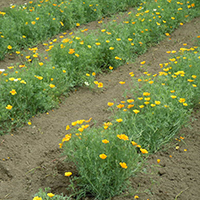Application of the environmental impact assessment to medicinal plants cultivation and drying in a hilly area of Campania Region (Southern Italy)

Accepted: 22 January 2020
HTML: 292
All claims expressed in this article are solely those of the authors and do not necessarily represent those of their affiliated organizations, or those of the publisher, the editors and the reviewers. Any product that may be evaluated in this article or claim that may be made by its manufacturer is not guaranteed or endorsed by the publisher.
Currently, in Italy the cultivation of tobacco has strongly decreased and there is the need to organize substitute production chains that take into account current market demands. Medicinal plants can represent a possible alternative and an opportunity for the Italian agricultural sector. The aim of the present study was to assess the quality and the environmental sustainability of medicinal plants cultivation and processing using different drying techniques in a hilly area of the Campania region. The research was designed to investigate two drying systems (the recovery of a wooden structure for drying tobacco in the open air and a specific electric prototype for drying medicinal plants) and five cultivated medicinal species (marsh-mallow, absinthe, Californian poppy, lemon balm, thyme). To assess and compare quality efficiency and environmental performance, the life cycle assessment methodology was applied according to the ISO 14040-44. The functional unit was the production of one kilo of dried medicinal plants and, to meet the objectives of the research, the system boundaries included the cultivation of the plants, their transport to the drying structure and the herbs drying. Priority was given to primary data in terms of input material typologies and amounts used to estimate direct and indirect emissions. Results showed a good adaptability of the species to the pedo-climatic environment with high biomass yields. Both drying structures allowed to reach a final product with high quality and low moisture. The cultivation and the drying of one kg of medicinal plants caused mainly marine and fresh water ecotoxicity, abiotic depletion, eutrophication, air acidification and global warming. The lowest impacts occurred when drying took place in the open air under the wooden structure. The combination of the two systems organized with a first phase of drying in the open air at the individual farms by recovering the tobacco structures, and the next artificial stabilization of the product at a cooperative center, would reduce the overall environmental impact and ensure the quality of the product regardless of the harvesting period. These results could be easily used to support the quality supply chain of medicinal plants with low environmental impacts. Moreover, they highlighted an encouraging approach to evaluate a resilient reorganization when different agricultural productions go into crisis.
How to Cite
PAGEPress has chosen to apply the Creative Commons Attribution NonCommercial 4.0 International License (CC BY-NC 4.0) to all manuscripts to be published.

 https://doi.org/10.4081/ija.2020.1505
https://doi.org/10.4081/ija.2020.1505



